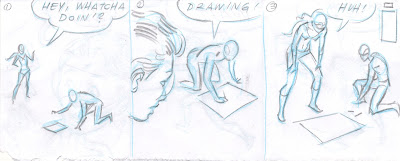A couple of commercial artist acquaintances asked me last night why illustration wasn't covered in their art history class at The Art Institute of Philadelphia. I have touched on this subject before (here and here), but let me see if I can't formulate a more succinct statement.
The short answer would be snobbery. A slightly longer answer is that art is that which rich people collect and educated (and overeducated) people study. An even longer answer might be that art history is extremely conservative and prone to a herd mentality.
Art history before World War I exemplified an Old Master ethos and a preference for allegorical subjects (nude nymphs and the like); at mid-century formalist modernism prevailed; these days it is a kind of theatrical political gesturing descended from Zurich Dada. It is not a question of left or right, so much as whatever the herd happens to be grazing on at the moment (i.e., wherever the funding can be located). Academia is nothing if not overwhelmingly conformist.
Michele H. Bogart is the author of one of the few scholarly works on the subject, entitled Artists, Advertising, and the Borders of Art (University of Chicago Press, 1995), a highly readable account of how institutions like the Metropolitan Museum of Art declined to collect illustration art when it had the chance. A few years ago she lamented to me that more scholars had not ventured into this territory.
Increasing work is being done on popular material of the past, but this is problematic because scholarship is only useful if it enlightens on meanings that have been lost over time. Baxandall is necessary because he reminds us of the lost context of Early Medieval art, but we really don't need scholars to interpret Rockwell or Maxfield Parrish for us, just yet. Although, as print itself disappears, along with the modernist prejudice against commercial art as capitalist commodity, this will change. For today's college students, it is increasingly necessary to explain what print is, and that there were creative minds who created visuals for that lost media, and that some of it is very worthwhile. (Academically, such work is appearing on the radar in something called "Visual Culture Studies," a kind of purgatory for tainted objects that have yet to pass the high-brow cultural snob test.)
The argument that triptychs and other premodern genres of art had not been
created for gallery display, but nonetheless had long incorporated into museological-academic art
history, still does not sway art historians who continue to discount art
made for reproduction on the grounds that, well, it was not made to hang on a gallery wall. Even obvious connections to illustration, such as the early careers of
Winslow Homer, Edward Hopper, Andy Warhol, and other American artists,
are overlooked or given incredibly short shrift. Marxist-inflected critical theory mandates that art intended for mass consumption is not art, while art sold to capitalist art collectors and capital-underwritten institutions somehow achieves ideological purity. In other words, ideological predisposition (snobbery) is still the primary determinant of what constitutes art.
Art that still speaks to us on a gut level does not need a wall text or a journal article. And, as Raymond Williams and Jonathan Miller remind us (in The Long Revolution and Subsequent Performances, respectively), all historical art of the past once spoke to a contemporary audience in an immediately comprehensible way. Paradoxically, and perversely, contemporary art does not speak to us very clearly at all, which is why current scholarship in art history has shifted so heavily in that direction. Such work cannot stand on its own (Tom Wolfe's point in the now dated and somewhat ham-handed The Painted Word). Art has to give writers employment, or, a picture has to be worth a thousand words (or a thesis or dissertation or paper or book chapter), or it's not really art, is it?
Illustration, no matter how skillful or talented or imaginative or creative, is merely illustration unless it can function as a conversation piece for critical theorist to expound a political discourse. We used to ask, "But is it art?" Now we have to ask, "But can it be used in a scholarly argument that advances a professional academic or institutional-museological career?" Once illustration crosses that threshold, it may be permitted to pass through the Pearly Gates into the discipline of art history.


No comments:
Post a Comment
Comments from anonymous, unidentifiable, or unverifiable sources will not be posted.